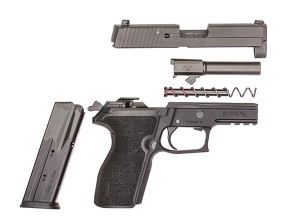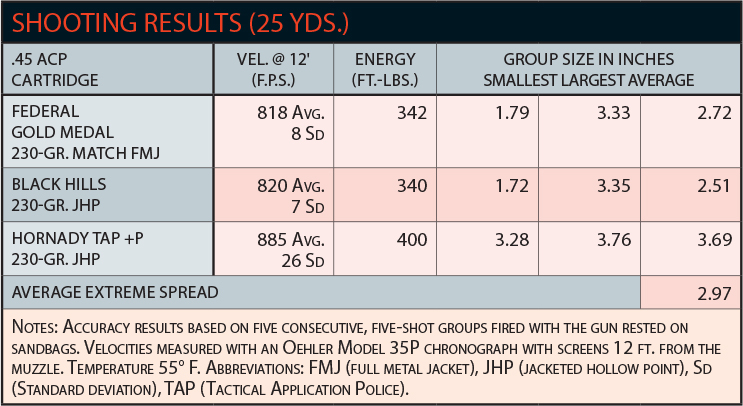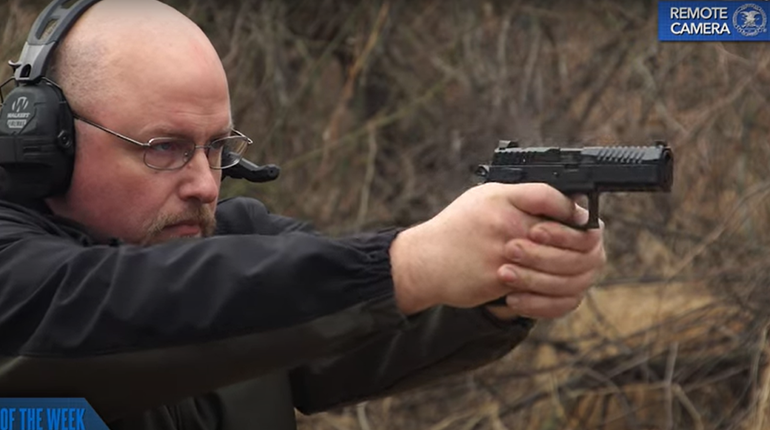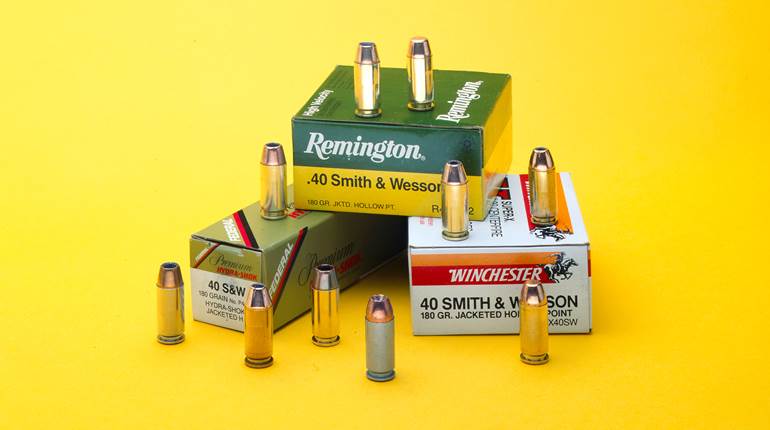
Four decades ago, the major handgun makers began to develop pistols in a new style-double-action lockwork, larger magazine capacity and high-visibility sights. One such maker was a newly formed cooperative of the German firm of J.P. Sauer & Sohn and the Swiss one of Sweizerische Industrie Geselleschaft. Through the intervening 40-plus years, there have been a number of changes in management and direction in the company now known as SIG Sauer. The firm’s primary pistols remain very much like the P220 introduced in the early 1970s.
Lightly updated P220s are still available. Although other makers have changed designs multiple times, SIG Sauer continues to build a line of pistols almost the same as the first. One might infer that they got it right the first time.
Early on, SIG Sauer understood the need for a .45 ACP pistol in the American market. For many years, the firm’s gun was one of the rare double-action .45 models. With the number of finish and size variants of the basic P220, you would assume SIG had every possible variation of the modern .45 ACP covered. Almost, but not quite-all of the P220s are single-column guns with capacities of no more than eight rounds. This brings us to the matter at hand-a new .45 ACP pistol from SIG Sauer with two additional rounds in the magazine. Rumored for years, the P227 is now available in several versions.
For fans of the .45 ACP cartridge, the only way to make a good .45 pistol better is to put more cartridges in the magazine. Unfortunately, that means a double-column magazine design and a wider butt section to accomodate it. Mechanically, this is no great problem; however, to build an ergonomically sensible pistol is tricky. SIG Sauer’s designers get high marks for the excellent size and handling characteristics of the new P227. Shooters already familiar with the main service pistols in the SIG Sauer line (P226, P229, etc.) should make an easy transition to the slightly larger P227. How much larger? Compared to the latest rendering of the classic 9 mm Luger P226, the butt section is right at 1/8-inch longer front-to-back and the same side-to-side. In actual circumference, there is about 3/8 inch difference between the two guns at the largest point. Yes, the P227 is a larger gun, but the difference is not great and is still manageable for most shooters.
Much of the reason is the clever shape of the one-piece stock. Earlier SIG pistols had a conventional two-piece stock system held in place by a pair of screws on each side. The new P227 has a beautifully contoured one-piece stock that snaps in place to cover the pistol’s lockwork. A special tool is required-and is provided-to remove the stock. Serious SIG shooters will not mourn the passing of those stock screws; they had a terrible habit of working loose. The new gun contours are excellent, with a deep pocket for the web of the hand. Also, the grip texture is outstanding; a grainy, stippled surface molded into the polymer. It covers the entire grip, except for a styled company logo near the heel of the butt. All in all, it is a very shootable shape and feel.
Interestingly, the P227 came with the same basic lockwork and operating system as the guns of the 1970s. It’s a recoil-operated locking system with a tilting barrel. Sound and solid, this system has been copied endlessly. The lockwork is not one of the currently popular double-action-only types, but rather a double-action/single-action with decocker and no manual safety. That means a loaded P227 with chambered round and hammer down responds to a long arc, double-action trigger pull of about 11 pounds. That raises and then releases the external spurred hammer to fire the first shot. As the pistol cycles, it is cocked for a subsequent shot in a crisp single-action pull. More single-action shots follow as they are needed, but a quick downward flick of the right thumb on the decocker drops the hammer and returns the action to double-action mode. There are advantages to such a system. For one thing, the lack of a manual safety speeds up the firing of a first shot and, once the hammer is cocked, all ensuing shots are fired with a clean single-action pull. As well, the ability to quickly return to hammer-down double-action operation after one or multiple shots is excellent and enhances safety. It is fast, flexible and pretty much foolproof.
The P227 is a 32-ounce pistol measuring 7.7x5.5x1.5 inches with a 4.4-inch barrel and  10-round magazine capacity. The receiver is anodized aluminum alloy, and the slide is nitrided stainless steel, both in a dull tactical black. The sights, dovetailed to the slide, are fixed and feature three-dot highlights, but other sight options are available. Further, SIG Sauer’s 2014 catalog shows four variations of the P227, including a Tactical model with a longer 14-round magazine and threaded barrel, and a Carry model with a slightly shorter barrel and slide. All guns except a special Carry model have an accessory rail on the dust cover. Some models have the special SRT trigger system with a trigger that resets more quickly than normal. A well-practiced operator can do wonders with this option.
10-round magazine capacity. The receiver is anodized aluminum alloy, and the slide is nitrided stainless steel, both in a dull tactical black. The sights, dovetailed to the slide, are fixed and feature three-dot highlights, but other sight options are available. Further, SIG Sauer’s 2014 catalog shows four variations of the P227, including a Tactical model with a longer 14-round magazine and threaded barrel, and a Carry model with a slightly shorter barrel and slide. All guns except a special Carry model have an accessory rail on the dust cover. Some models have the special SRT trigger system with a trigger that resets more quickly than normal. A well-practiced operator can do wonders with this option.
At the range, I fired the new SIG extensively. There were no malfunctions in more than 300 rounds downrange. I also deliberately limp-wristed the gun in an effort to induce malfunctions and had no luck. The pistol chugged through magazine after magazine of mixed ammunition without a problem. I had two other pistol shooters fire the P227 to get additional opinions, and both liked it. I also ran it through the standard American Rifleman accuracy protocol of five consecutive, five-shot groups at 25 yards. In the absence of proper Ransom Rest inserts, I fired the gun by hand from the bench.
The P227 is best controlled with a firm grasp. I do not imply that malfunctions will result if it is not held strongly, but the gun shifts in a light grip. Frankly, this is a full-size pistol and, like most SIGs, sits rather high in the shooter’s hand. With full-power loads, its muzzle tends to flip up, and only a strong grip and locked wrist are going to help out. The long, double-action trigger pull is rather smooth and releases at 11 pounds. Once the recoiling slide cocks the hammer, the subsequent single-action pulls break cleanly at 4 pounds. Because that shot requires a long-arc double-action pull, there is no manual safety, making the gun, in that respect, somewhat like a revolver. In a world full of different trigger systems, I consider this one to be the best. It fit my hand well, and I was able to reach the slide lock, decocker and magazine catch without shifting my grip on the pistol.
The most immediately obvious place for the P227 is in police service or, possibly, by units within the military’s special operations community. A tough gun to hide on one’s person, the new SIG is built for heavy service in an external holster. Home defense is another option and a role where size is a not a material selection criterion. A P227 set up with one of the better rail-mounted lights would make a good choice. Gunsite Academy teaches shooters to engage hostile threats with a fast pair of shots. They also teach not running the gun dry of ammunition, but rather changing magazines before the slide locks back on empty. With the P227, there are five pairs and one spare. Properly used, that should be enough to mitigate most threats.
With the addition of the 10-round-capacity P227 and the upgrading of the P226, SIG Sauer moves forward strongly in viable pistol options. In large measure, its success is a good bet, since the guns are based on pistols made when the company started.
Manufacturer: SIG Sauer, Inc., 72 Pease Blvd., Newington, N.H., 03801; (603) 772-2302
Caliber: .45 ACP
Action Type: recoil-operated semi-automatic pistol
Frame: aluminum alloy
Barrel: 4.4 inches
Rifling: six-groove, 1:16-inch LH twist
Magazine: detachable box, 10-round capacity
Sights: drift-adjustable front and rear, three-dot
Trigger: double-action, 11-pound pull; single-action, 4-pound, 7-ounce pull
Overall Length: 7.7 inches
Width: 1.5 inches
Height: 5.5 inches
Weight: 32 ounces
Accessories: owner’s manual, lock, case, spare magazine, dismount tool
Suggested Retail Price: $1,108-$1,250






































